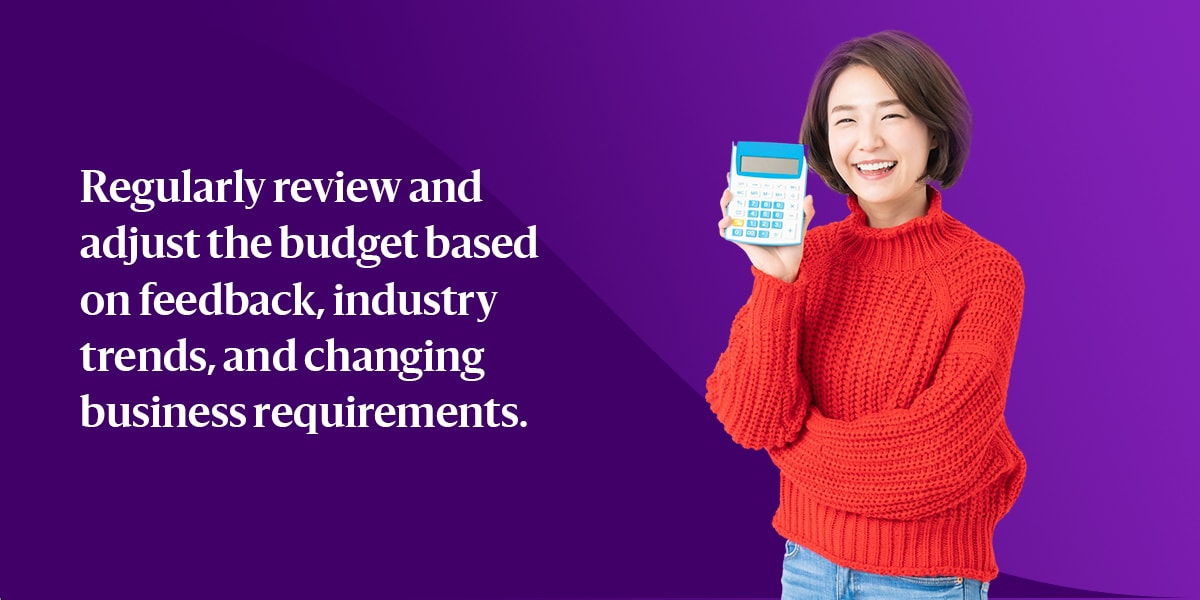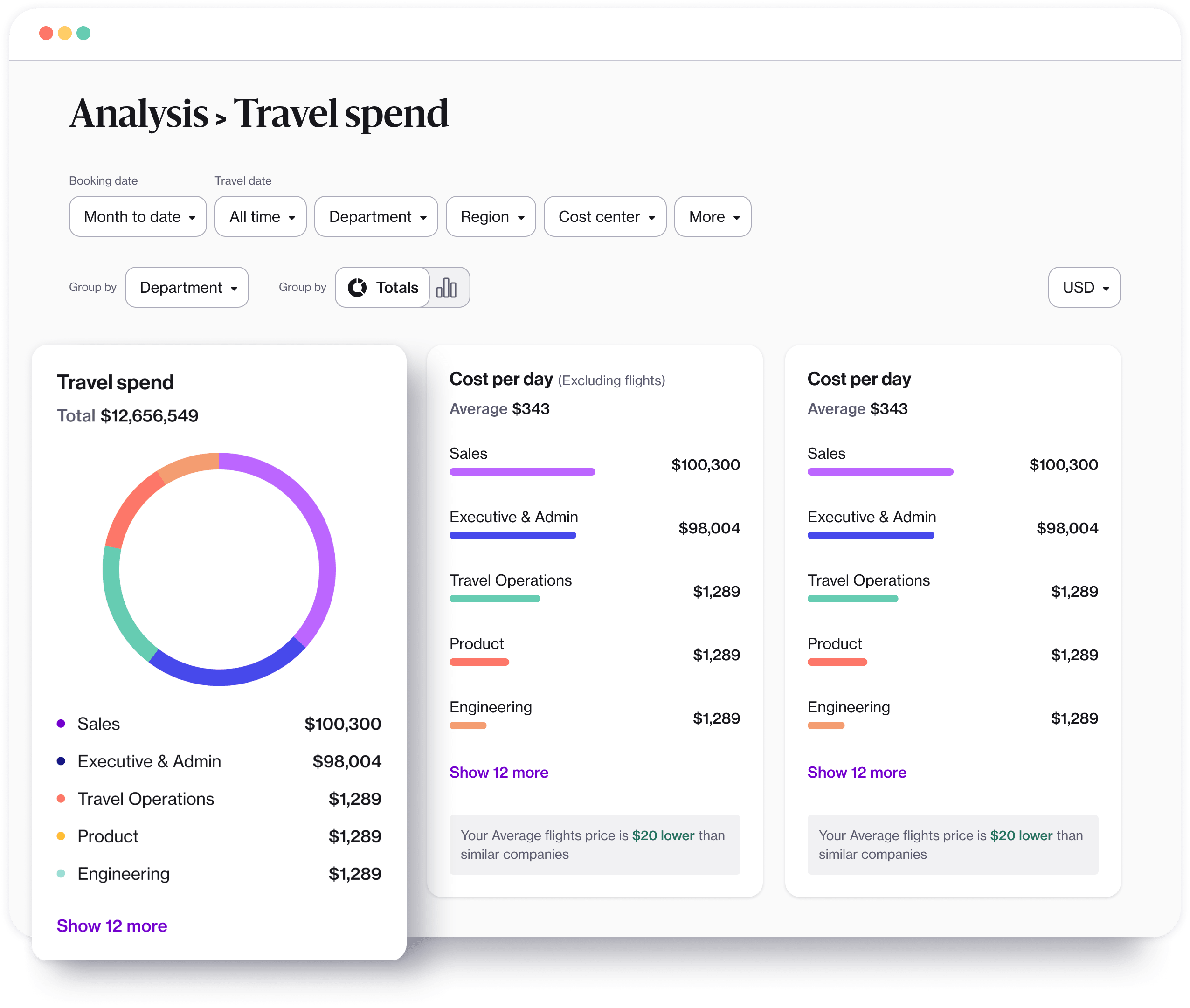5 Steps to Build a Corporate Travel Budget
The Navan Team

Business travel is a cornerstone of building relationships, sealing deals, and driving growth.
A well-crafted travel budget is your roadmap to success. It empowers travel managers and finance teams to track costs, make smart decisions, and avoid financial pitfalls. The key? Doing it right.
Dive in to discover how to rein in travel expenses and maximize the company’s ROI — without sacrificing the benefits of being there in person.
5 Steps for Creating a Business Travel Budget
Like many other operational costs, companies must budget for the expenses associated with essential business travel. Here are five practical tips for setting a corporate travel budget.
1. Identify Your Company’s Travel Objectives
What is the purpose of business travel for your company? What specific goals does the company hope to achieve? If you can’t answer those questions, it will be difficult to establish guidelines for business travel spending and get all stakeholders to agree on a business travel budget.
Are you looking to expand into new markets, strengthen client relationships, attend industry conferences, or explore partnership opportunities? Determine which travel initiatives are critical for achieving your corporate goals so you can effectively allocate resources.
Next, set measurable performance metrics for the company goals. These metrics could include:
- Sales targets
- Client acquisition rates
- Partnership agreements
- Number of leads generated
Aligning travel objectives with measurable outcomes allows for better budget justification.

2. Understand Past Travel Patterns
Look at past travel bookings for patterns to make a realistic business travel budget. Understanding the average length and cost of past business trips can help your company make more accurate expense forecasting.
Travel expense categories to look into include:
- Conference and event fees
- Lodging and hotel rates
- Airfare costs
- Meal expenses or per diems
- Car rental prices
- Mileage reimbursements
- Transfers and ground transportation costs
- Visa and insurance fees
- Baggage fees
- Incidental expenses
Beyond the breakdown of expenses and the total average cost of the trip, you’ll also want to understand the peak travel times for your company and which departments travel. Conferences or networking seminars typically occur annually, and certain departments — like sales and finance — tend to travel more.
Now that you know how much an average business trip costs, you can start building a more detailed budget. Determine how much your company can afford to dedicate to travel while considering other business expenses like payroll, rent, and utility bills.

3. Consider External Factors
When putting together a business travel budget, it’s crucial to consider various external factors that may affect your expenses. These could include:
- Economic conditions: Exchange rates, inflation rates, fuel prices, and overall market stability can affect travel expenses.
- Seasonal demand: Popular tourist destinations tend to have higher prices during peak seasons, which can affect airfare, hotel rates, and availability.
- Industry events and conferences: Big events attract many attendees, increasing demand for flights and accommodations.
- Travel regulations: Changes in visa requirements, entry restrictions, or security protocols can affect international travel plans and lead to additional fees.
- Geopolitical situations: Political instability, natural disasters, or security concerns can have an effect on travel safety and cost. Monitor global and regional developments to assess potential risks.
Travel Smarter with Expert Help
Forecasting external factors can be a real headache. That’s where a global business travel management company comes in. Think of them as corporate travel pros who handle the duty of care, keep you updated on changing conditions, and help optimize your travel budget.
With Navan, dynamic policies automatically adjust to market conditions — even during high-demand events like when Taylor Swift is in town.

4. Define a Business Travel Policy
A business travel expense policy helps companies manage employee expenses for those on the road. It helps make business travel effective, cost-efficient, and easy for everyone involved.
A good corporate travel policy should:
- Set clear business travel guidelines
- Outline expenses that are covered
- Provide information on the booking and approval process
- Detail the expense report and expense reimbursement processes
In short, a business travel policy clarifies travel practices and travel expenses to all employees. It is a tool to help business travelers stay within policy compliance. Road warriors can keep the policy on hand to help ensure they understand what is deductible while on a business trip.

Above: A desktop view of travel spend analysis using the Navan app
5. Monitor Expenses and Look for Cost Savings
Implement a robust expense tracking system to monitor actual expenses against the budget. This practice will help identify deviations, spot potential areas of overspending, and inform future budgeting decisions.
Monitoring expenses and noticing trends can make business travel more affordable and improve the traveler experience. Some common ways to reduce expenses include:
- Book ahead of time: Generally, airfare is less expensive the further in advance it is purchased. Consider requiring employees to book trips a minimum number of days in advance.
- Encourage public transportation: Employee transfers can be more affordable than rental cars or rideshare services. Consider public transportation like trams, trains, and buses.
- Choose flexible bookings: Prepare for unforeseen circumstances like rescheduled meetings or sick employees by selecting flexible booking options. This way, the company can get a refund on airfare or accommodations in the event of cancellations.
- Specify upgrades: Ensure employees know which flights, if any, entitle them to an upgrade (e.g., flights above a certain number of hours).
- Use a corporate travel management app: Planning trips can be time-consuming and costly. Travel management apps enable employees to book and manage trips in one place, minimizing time and effort for both travelers and administrators.
Corporate travel management companies can also connect your business with corporate negotiated rates. Navan has negotiated up to 15% off the best available rates at thousands of hotels globally.
What Is a Reasonable Business Travel Budget?
Determining a reasonable business travel budget can vary significantly depending on factors such as the company’s size, industry, travel objectives, destinations, and employee roles.
Some general considerations to help establish a reasonable business travel budget include:
- Industry standards: Research industry benchmarks and best practices to gain insights into typical travel budgets within your sector.
- Travel objectives: Different travel initiatives have varying cost implications. Attending an industry conference across the country requires a higher budget than driving to a local client meeting.
- Cost of living: Consider the cost of living associated with the destinations your employees will visit. Meal expenses are different in New York City vs. Nashville. A standard per diem might not make sense considering the cost of dining in the destination.
- Employee roles: Consider the positions and responsibilities of the traveling employees. Senior executives may require a higher travel budget due to the potential need for client entertainment or premium flight and accommodation options.
Remember, a reasonable business travel budget should strike a balance between meeting the needs of the business and ensuring responsible financial management. Regularly review and adjust the budget based on feedback, industry trends, and changing business requirements.
Manage Your Corporate Travel Expenses With Navan
Navan is an all-in-one travel and expense management software that helps large and small businesses/startups control and monitor employee travel expenses.
With Navan, companies can:
- Guard their travel budgets: Allow employees to book independently with dynamic policies that give them the confidence they’ll never overspend.
- Incentivize travelers to reduce company costs: Navan pushes savings forward by rewarding travelers for booking smart and saving company money. It’s a win-win!
- Close the books in record time: Automate the expense process from credit card swipe to reconciliation and say goodbye to expense reports and receipt chasing, reducing month-end close from days to minutes.
Are you ready to start implementing cost-effective travel solutions? Schedule a demo.
More on Corporate Travel Budgets
This content is for informational purposes only. It doesn't necessarily reflect the views of Navan and should not be construed as legal, tax, benefits, financial, accounting, or other advice. If you need specific advice for your business, please consult with an expert, as rules and regulations change regularly.
More content you might like
Take Travel and Expense Further with Navan
Move faster, stay compliant, and save smarter.
